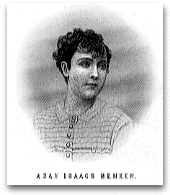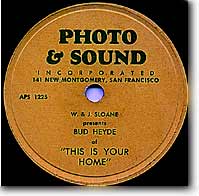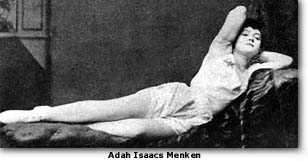 By Samuel Dickson Johnnie Heenan was a prize fighter. He had thick, black hair; heavy, black eyebrows; a thick, black mustache, and a brutal punch. He was born in the small California town of Benicia and was known around the world as the Benicia Boy. He fought, as was the custom of his times, with bare fists. He was the boxing champion of America. He met Tom Sayers, the international champion, in London, and after they had fought for more than two hours and thirty seven rounds during which Johnnie knocked Sayers down twenty times–the British fight promoters, afraid that Johnnie would kill Sayers, called the fight off and naïvely called it a draw. Now, this is not to be the story of the Benicia Boy. But he is important here because he married the lady who was destined to be the most sensational actress–not the greatest but the most sensational actress–San Francisco had ever seen. She was Mrs. John C. Heenan. She was also Mrs. Robert Henry Newell. She was also Mrs. James Barkley, and she was Mrs. Alexander Isaac Menken. At birth she was named Adah Bertha Theodore. To the world she was the notorious, glamorous, beautiful, and infamous "Mazeppa."
Not until 1938 were the probable facts of her birthplace and paternity established. Prior to that time she was variously reported to have been born in New York, Havana, and a half-dozen other places. She was said to have been born of a distinguished, old Southern family; another account claimed she was born in Arkansas of a French mother and an American-Indian father. Throughout the years of her life she consistently confused the issue by telling conflicting and varying stories, partly because she was ashamed of her parentage and partly because she was an actress always playing a role. The likeliest facts seem to be that Menken was born in New Orleans on June 15, 1835, that her mother was a very beautiful French Creole, that her father was Auguste Theodore, a highly respected "free" Negro of Louisiana. She danced, when a child, in the ballet of the French Opera House in New Orleans. She was exceedingly bright; an exceptional scholar. She spoke French and Spanish fluently; she painted, wrote poetry that was of good quality and brought her early recognition. From New Orleans she went, while still a child, to Havana, danced there, and was crowned queen of the Plaza. Then she forsook the ballet and turned to the stage and, on tour, landed in Texas. And in Texas, at the age of twenty-one, she married a very handsome and distinguished musician, Alexander Isaac Menken. She adored Menken, and Menken worshipped her. But with the characteristics and traditions of his Jewish forebears, Menken wanted a wife, a home, a family. Adah was not at all interested in home or family; in fact, the only thing she shared sincerely with him was his religion–she adopted the Jewish faith and remained steadfast in it until her death. But as for home life–no. Adah preferred the adulations of her audience and the adoration of the young men who gathered at the stage door, arms heavy with roses. Menken swallowed his jealous pride as long as he could, but when Adah insisted on smoking cigarettes in public, that was the last straw. Ladies did not smoke! Menken left her. So Adah Menken went her exciting way from town to town, and men fell in love with her and her poetry, with her intellect and her lovely face and her exquisite figure. And rather than see them unhappy, she was generous in her love. In New York she met the Benicia Boy. He was a strong, a brutal man, not unattractive in his strength. His fame as a pugilist had traveled ahead of him, and Adah was fascinated. She married him. On their honeymoon the Benicia Boy taught her to box; she soon learned to hold her own when they sparred good-humoredly. But after a month of marriage the good humor went out of it, and Heenan made a practice of beating Adah every night after dinner. So she divorced him. But then scandal broke. Search of the records showed that before marrying the Benicia Boy she had neglected to divorce Menken. She was quite, innocent about it all; she had assumed it was the duty of the man of the family to attend to legal matters, including such details as divorce. But now the scandalmongers declared her a bigamist. Menken heard of the scandal, did the gentlemanly thing and divorced her, and everybody was happy. Then Adah Menken gave birth to the Benicia Boy's son, and the baby died at birth. She had wanted, longed for, adored that baby. Its death, and the scandals, and her two marriages and divorces–all these coming swiftly one upon the other–were forerunners of a long period of tragic sorrow and failure. But never discouragement,– she would never give up. She starved in New York. She gave readings from Shakespeare. She gave lectures on the life of the times. She had a boyish figure and she always wore her hair short–so, suddenly she appeared as Mr. Bones, blackface, in a minstrel show. Then, on the variety stage, she created a sensation by impersonations of Edwin Booth as Hamlet and Richelieu. But something–something truly sensational had to be done to make the public fully aware of her. She met Blondin. Blondin was the brave gentleman who crossed the whirlpools of Niagara Falls on a tightrope. Blondin was enraptured by the beauty of the Menken. He wooed her, and she said perhaps–perhaps she would marry him if he would let her dance on the tightrope above Niagara with him–a husband-and-wife act. Blondin said, "No." He was afraid Adah's beauty would distract him when he was above the whirlpool and he would fall to his death. No, he would do no tightrope act with the Menken. So they went on a vaudeville tour together. That tour ended and Blondin went his way and Adah went hers, and hers led to the door of her business manager, Jimmie Murdock. Adah told Jimmie, who adored her, that she wanted to be a great tragedienne–or a great comedienne–or both. She wanted to play Lady Macbeth. and–or–Lady Teazle. Jimmie Murdock, something of a diplomat, told her she was too great to play Lady Treazle and not great enough to play Lady Macbeth, but that, because her boyish figure was so lovely and there was such fire in her voice and eyes, she should play in Mazeppa, the drama that was attracting some attention on Broadway. The story was based on the poem of Lord Byron. At the thrilling climax of the play, the noble Tartar lad, stripped of his clothes by his captors and bound to the back of a wild horse, dashed out of the wings up to the papier-mâché cliffs and disappeared in the clouds, while the audience grew hysterical with apoplectic applause. It had been a tradition that during the ride of the barebacked horse, a stuffed dummy, naked and resembling Mazeppa, would be used. Menken would have no stuffed dummy. She would ride the horse herself. She would wear skin-tights. No matter how it shocked the audience that had never seen an actress in tights, she would play the role with dramatic realism; she would wear tights. So she wore tights. The audience was shocked–scandalized–horrified–and delighted! But New York was too stilted, too smug, too proper truly to appreciate great art. And Adah Menken said, "I'll go to the one place where the audience demands real art; I'll go to San Francisco." On August 24, 1863, that supreme master of San Francisco's theatrical history, Tom Maguire, announced and presented at Maguire's Opera House the great Menken in the daring, the sensational, the unprecedented Mazeppa in which "Miss Menken, stripped by her captors, will ride a fiery steed at furious gallop onto and across the stage and into the distance." According to the San Francisco papers of the next day, that night all the streets leading to Maguire's Opera House were thronged with the most elegant of the city's elite. Ladies in diamonds and furs rode up in handsome carriages; gentlemen in opera capes and silk hats were their attendants. It was a first night such as the city had never before seen. And when (again quoting the San Francisco papers), at climax of the play, the Menken vaulted to the back of her full-blooded California mustang and, clad tights with hair streaming down her back, raced her steed at mad pace across the mountains of Tartary, the enthusiasm of the audience was a mad frenzy never to be forgotten. So thrilling was the performance that it was said that on the opening night the leading man, Junius Booth–brother of Edwin–stood in the wings and completely forgot his lines. Among the young men in the audience that night, and night after night that followed, were the three friends–Bret Harte, Joaquin Miller, and Charles Warren Stoddard. And these three, and scores of others, fall in love with Adah Menken, and it was even whispered that she was lavish with her love in return. But of all her admirers, she smiled on the young American humorist, Robert Henry Newell, and he became her third husband. Bohemian San Francisco took Adah Menken to its gay and ample bosom, She was an actress and it loved actresses; she was a painter, and it loved artists; and, above all, she was a poetess, and it adored poets and poetesses. wherever you went, to whomever you talked, the two favorite topics of conversation in San Francisco–topics of equal importance –were the progress of the Civil War and the success of Adah Isaacs Menken. Her fame increased. Imitators sprang up. In fact, one of these was Big Bertha, the circus fat lady who had played Juliet opposite Oofty Goofty's Romeo at the Bella Union. Big Bertha played Mazeppa in pink tights, strapped to the back of a donkey. But one night the donkey, with huge Bertha astride him fell over the footlights into the theater pit, and the career of Bertha as Mazeppa ended. Adah Menken's marriage to Robert Newell lasted two years. Then she divorced him and married Mr. James Barkley about whom little is known. After all, none of her husbands was important in the life of Adah Menken. And San Francisco went on adoring her, the San Francisco that had adopted her as its favorite daughter. The St. Francis Hook and Ladder Company made her a member of its fire-fighting brigade; she was presented with a beautiful fire belt, and the entire brigade, accompanied by a brass band, serenaded her. Her world was at her feet. And then, quite suddenly the Menken decided she wanted new worlds to conquer. She took Mazeppa to Paris and London. During the tour she fell in love with, and was adored by, Alexandre Dumas, pére. Dumas, fils, threatened to horsewhip his father for being a senile Romeo. So Menken left Dumas and went to London. She played Mazeppa, and London went wild. Charles Dickens fell in love with her; Charles Reade fell in love with her; Dante Gabriel Rossetti, Tom Hood, and a score of others wooed her. And, as always, the Menken was generous with her love. Life was full and rich and exciting. But the tide turned. Ill health, the fruit of dissipation, wasted her away. She had made a fortune; her great wealth disappeared, and she lived in comparative poverty. In London, desperately in need of funds, she published her volume of Victorian poems and realized a few dollars. London was cold, unfriendly. She returned to Paris and Paris had found new loves. Faithful to her adopted religion, she spent her last hours speaking of life and faith and hope to a friendly rabbi. Then she wrote a brief note to an acquaintance. It was her hail and her farewell. She wrote, "I am lost to art and life. Yet, when all is said and done, have I not at my age tasted more of life than most women who live to be a hundred? It is fair, then, that I should go where old people go." Then she died. She was thirty-three years old. Her passing was unmarked, save for a brief eulogy in verse that appeared in a Paris paper: Ungrateful animals, mankind; 
Samuel Dickson was a prolific magazine writer in the 1920's and early 30's, and became an NBC feature writer in the late 1930's. He wrote the NBC-KPO/KNBC series "This is Your Home," sponsored by W. & J. Sloane, then one of San Francisco's leading furniture stores. The series was narrated by NBC-KPO/KNBC (now KNBR) announcer Budd Heyde and was broadcast during the late 1940's and into the 1950's. This Adah Isaacs Menken chapter was one of the KPO/KNBC radio scripts later printed in "San Francisco is Your Home," Stanford University Press, 1947. Budd Heyde can be heard on this promotional 78-rpm phonograph record commissioned by W. & J. Sloane sometime during the late 1940s The recording, in addition to promoting the radio program, was given to owners of new record players purchased from Sloane's.
|
 Adah Menken was to the San Francisco of Civil War days what
Adah Menken was to the San Francisco of Civil War days what